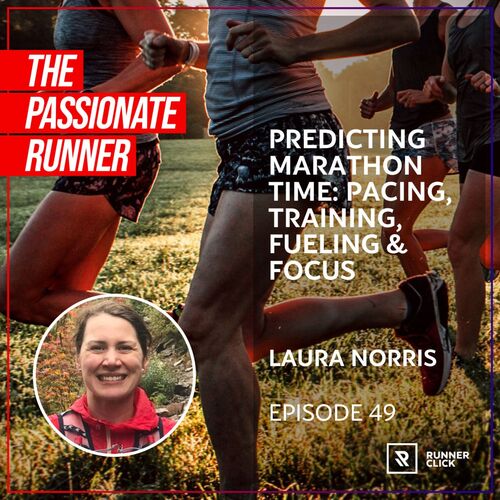
049 Laura Norris - Predicting Marathon Time: Pacing, Training, Fueling & Focus
Episode · 0 Play
Episode · 52:33 · Dec 6, 2023
About
Episode SummaryLaura Norris is a certified running coach, small business owner, writer, and content creator. She believes in a blended approach to coaching that utilizes both evidence-based methods of training and a holistic approach of coaching the runner as a person first, athlete second. Laura’s philosophy emphasizes sustainability, enjoyment, and long-term growth. Today, Whitney and Laura talk all about how to predict your marathon time. They discuss pacing, pickups at the end of long runs, and the different types of running calculators, including Jack Daniels’ VDOT. Finally, Laura provides tips and best practices on tapering, fueling and when to heighten your focus on your marathon goals.Episode SponsorRunner Click Pro – https://pro.runnerclick.com/Key Takeaways01:12 – Whitney Heins welcomes Laura Norris back to the show to discuss her CIM Training and how to predict your marathon time12:09 – Pacing and Jack Daniels’ VDOT running calculator20:27 – Other popular running calculators25:12 – Best workouts to help inform what your marathon time will be28:01 – How to determine your marathon pace30:52 – Pickups at the end of a long run36:12 – The Garmin Race Predictor, easy miles, and long-run pace43:01 – The best time to focus on your goal time and marathon tapering46:02 – Fueling and other best practices to implement prior to race day50:21 – Whitney thanks Laura for joining the show and lets listeners know where they can connect with herTweetable Quotes“Picking an arbitrary goal time is a sort of reverse engineering that doesn’t work in training, because you’re not this robot who you can input, ‘I want to run a nine minute mile pace’ which is roughly what you want for a sub-four hour Marathon. Unfortunately, training doesn’t work that way. A lot of times people see these nice round numbers or there’s some sort of excitement around them, but you just can’t program a number into your body. It’s all dependent upon where your current fitness is and where your aerobic capacity is.” (10:26) (Laura)“For most runners, taking a 10k or longer will give them a more accurate result than taking a mile or a 5k just because those shorter distances have more anaerobic contribution. And that’s when you’re getting into differences of muscle fiber typology. So, you can have someone who really excels in the Marathon and once they get into anything above their critical speed, they aren’t as fast as the equivalent race times would predict.” (17:34) (Laura)“Once we get to four and a half to five hours and five and a half to six, your marathon pace is gonna have a lot of overlap with your easy pace. And, when we talk about marathon pace, it’s not always this reverse engineered X minutes per mile faster than your easy pace. It’s about the pace you can sustain for a certain duration.” (25:33) (Laura)“One workout that I find that is really great is to do ten minutes at threshold, thirty minutes at threshold, all those ones that push the upper end of threshold and really rely on the ability to control your pacing and then kinda add to thet.” (30:36) (Laura)“Where you are eight weeks out from your marathon is not where you’re gonna be in your marathon. And, if you’re reaching peak fitness eight weeks out from a marathon, you should probably be worried. You’re probably overtraining.” (43:39) (Laura)“Carbs are the spark that’s gonna fuel the fire of the marathon. You need that substrate. You’re putting gas in your tank. No one’s giving out medals at the end for running the marathon on the fewest carbs.” (48:19) (Laura)Resources MentionedWhitney’s LinkedIn – <a href="https://www.linkedin.com/in/whitney-heins-02ba3b5" rel="noopener noreferrer"...
52m 33s · Dec 6, 2023
© 2023 Captivate Audio Ltd. (OG)